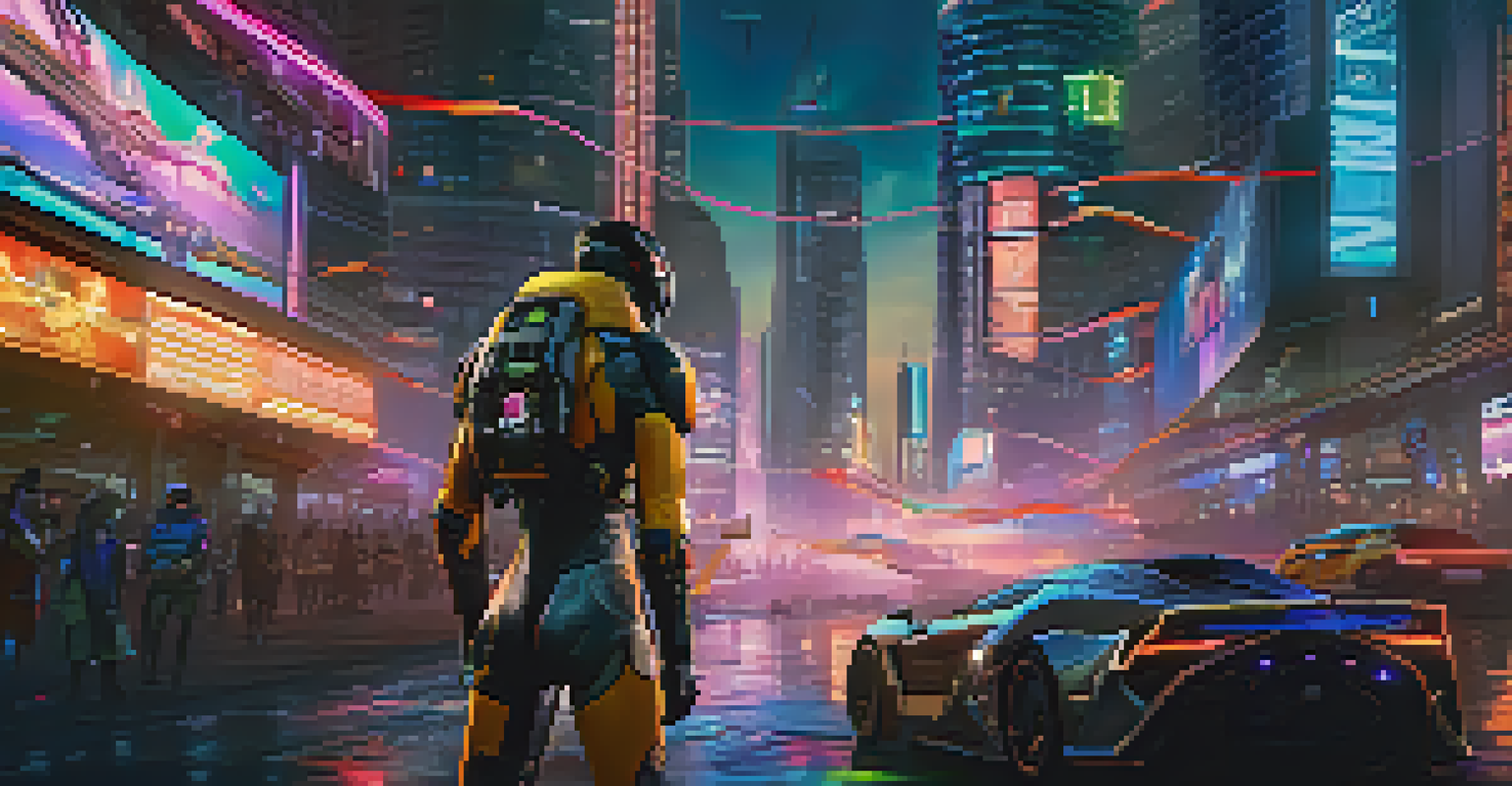From Screen to Console: Hollywood's Impact on Game Design

The Cinematic Evolution of Video Games
Video games today often mirror the storytelling techniques seen in Hollywood films. Many titles employ cinematic techniques such as camera angles, voice acting, and scriptwriting that resemble those found in movies. This evolution allows players to immerse themselves in rich narratives, making them feel like active participants in a story rather than mere spectators.
Video games are the ultimate interactive medium, where players can experience stories, emotions, and worlds in ways that films cannot.
Consider games like 'The Last of Us' or 'God of War,' which feature deeply developed characters and emotional arcs reminiscent of blockbuster films. These games have not only raised the bar for narrative depth in gaming but have also attracted attention from filmmakers and actors looking to collaborate. This cross-pollination of ideas highlights how closely intertwined the two industries have become.
As technology advances, we can expect even more cinematic elements to be integrated into gaming. With the rise of powerful graphics engines and motion capture technology, the line between film and video game experiences continues to blur, leading to a new era of interactive storytelling.
Storytelling Techniques Borrowed from Hollywood
Hollywood has long been a master of storytelling, and video games have adopted many of these techniques to enhance player engagement. From character development to plot twists, the narratives in modern games often reflect the same structures found in successful films. For example, many games use a three-act structure, which helps build tension and keeps players invested in the outcome.

Additionally, the use of dialogue trees and branching narratives allows players to influence the story, creating a more personal experience. This interactive storytelling approach can be seen in titles like 'Mass Effect,' where player choices significantly impact the storyline, similar to how choices drive character arcs in movies.
Games Embrace Cinematic Storytelling
Video games increasingly utilize cinematic techniques, such as character development and emotional arcs, to create immersive narratives similar to those in Hollywood films.
By borrowing these storytelling methods, game designers can create deeper connections with players, making them care about the characters and outcomes. This not only enhances the gameplay experience but also establishes games as a legitimate storytelling medium alongside film.
The Role of Voice Acting in Game Design
Voice acting has become a crucial element in video game design, heavily influenced by Hollywood's talent pool. Just as actors bring characters to life on the big screen, voice actors do the same in games, giving depth and personality to digital avatars. High-profile actors like Nolan North and Troy Baker have made their mark in the industry, elevating the art of voice acting in gaming.
The best stories are those that can be experienced differently by each person. Video games allow for that unique interaction.
The impact of professional voice acting is evident in the emotional resonance of game narratives. Players can connect with characters in a way that feels authentic and relatable, much like they do with their favorite movie stars. This connection enhances the overall gaming experience, making players more invested in the outcome of the story.
As the demand for high-quality storytelling in games continues to grow, the collaboration between game developers and Hollywood talent is likely to increase. This trend not only enriches the narratives but also challenges the perception of video games as a form of entertainment.
Cinematic Techniques Enhancing Gameplay
Game designers have increasingly adopted cinematic techniques to enhance gameplay experiences. Techniques such as cutscenes, dynamic camera angles, and quick-time events help to immerse players in the game's world. These elements can make players feel as though they are part of an epic movie unfolding around them, elevating the excitement and engagement levels.
For instance, titles like 'Uncharted' and 'Resident Evil' incorporate such cinematic flair, seamlessly blending gameplay with storytelling. The result is a more engaging experience where players are not just completing objectives but are also immersed in a thrilling narrative. This shift towards cinematic gameplay continues to redefine what players expect from their gaming experiences.
Voice Acting Enhances Game Narratives
Professional voice acting adds depth to characters in video games, allowing players to form authentic connections that enhance their overall experience.
As these cinematic techniques evolve, we can anticipate even more innovative ways to engage players. The merging of film and gaming will likely lead to experiences that challenge traditional storytelling boundaries, creating a new frontier for interactive entertainment.
The Influence of Game Adaptations in Hollywood
The rise of video game adaptations in Hollywood speaks volumes about the impact of the gaming industry on film. Successful franchises like 'Tomb Raider' and 'Detective Pikachu' show that games have rich stories and characters, worthy of the big screen. These adaptations often draw on the game's visual and narrative elements, creating a bridge between the two mediums.
However, not all adaptations have been successful, highlighting the challenges of translating interactive experiences into linear narratives. A film must capture the essence of a game while appealing to a broader audience, which can be a tricky balancing act. The success or failure of these adaptations often influences how game designers approach storytelling in their own titles.
As Hollywood continues to explore video game stories, it opens up opportunities for collaboration between filmmakers and game developers. This synergy could lead to more cohesive storytelling across platforms, benefiting both industries and further blurring the lines between film and gaming.
The Future of Games: Merging Film and Gameplay
Looking ahead, the future of video games is likely to see an even more significant merging of film and gameplay elements. As technology advances, we may witness the rise of fully interactive films where players can influence the storyline in real-time. This would create a new genre that combines the best of both worlds, providing an experience that is both cinematic and interactive.
Moreover, virtual reality (VR) and augmented reality (AR) are set to revolutionize how we experience stories. Imagine stepping into a movie and becoming an active participant in the narrative, making choices that affect the outcome. This potential for immersive storytelling could redefine the landscape of both gaming and filmmaking.
Future Merges Film and Gameplay
Advancements in technology may lead to fully interactive films, creating a new genre that blends the immersive qualities of both gaming and cinematic storytelling.
As these technologies evolve, game designers will continue to draw inspiration from Hollywood, and vice versa. The collaboration between the two industries will undoubtedly yield innovative experiences that challenge our understanding of storytelling.
Conclusion: A New Era of Interactive Storytelling
In conclusion, the impact of Hollywood on game design is profound and multifaceted. As video games increasingly adopt cinematic elements, they become richer and more engaging, offering players unique storytelling experiences. This synergy not only enhances the gaming experience but also elevates the medium as a whole, allowing it to stand alongside traditional film.
With the continued collaboration between filmmakers and game designers, we can expect even more innovative narratives that resonate with players. The storytelling techniques borrowed from Hollywood have forever changed how games are designed, making them a dynamic form of entertainment.

As we move forward, the future of gaming looks bright, with endless possibilities for creativity and storytelling. The merging of film and gameplay is just the beginning of a new era in interactive storytelling, and we can't wait to see where it leads.